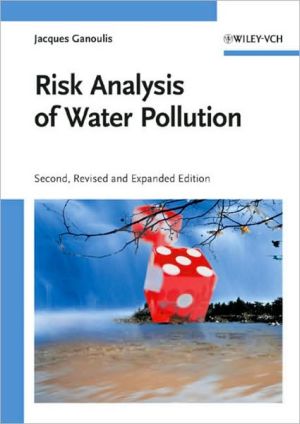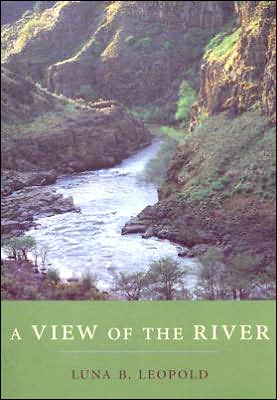Risk Analysis of Water Pollution
This new edition of a classic text has now been extensively updated to include the latest developments in risk analysis and water quality assessment and management. It takes into account the role of ecological water quality in integrated regional and transboundary water resources management, according to the latest UNESCO programmes and the new EU-Water Framework Directive.\ This practice-oriented textbook is a unique tool for identifying and evaluating local and regional environmental risks...
Search in google:
This new edition of a classic text has now been extensively updated to include the latest developments in risk analysis and water quality assessment and management. It takes into account the role of ecological water quality in integrated regional and transboundary water resources management, according to the latest UNESCO programmes and the new EU-Water Framework Directive. This practice-oriented textbook is a unique tool for identifying and evaluating local and regional environmental risks from pollution hazards in groundwater, river water and coastal seawaters. The book explains different risk-based probabilistic methodologies and fuzzy logic-based approaches and includes various mathematical models for water quality simulation and theories, such as the decision analysis, the utility theory and the integrated risk-based multi-criteria assessment and management, in order to thoroughly evaluate several case studies from the real world. Questions testing the reader's understanding are given at the end of each chapter, and a useful appendix provides hints for answering them as well the solutions themselves.
Preface to the Second Edition. Preface to the First Edition. 1 Water Resources: Quantity and Quality. 1.1 Water Pollution and Risk Analysis. 1.1.1 A Systemic View of Water Resources. 1.1.1.1 Examples of Application. 1.1.2 The New Paradigm of Water Quality. 1.1.2.1 Human Well-being and Health. 1.1.2.2 Ecological Impacts and Biodiversity. 1.1.2.3 Fishing and Oyster Farming. 1.1.2.4 Tourism. 1.1.2.5 Algal and Chlorophyllic Photosynthesis. 1.1.2.6 Zooplankton Growth. 1.1.2.7 Bacteria. 1.1.3 Integrated Water Resources Management. 1.2 Water Pollution in Transboundary Regions. 1.2.1 The UNECE Convention (Helsinki, 1992). 1.3 The EU Water Framework Directive. 1.4 Uncertainties in Water Resources Management. 1.5 Environmental Risk Assessment and Management. 1.6 Aim and Organisation of the Book. 1.7 Questions and Problems – Chapter 1. 2 Risk Identification. 2.1 Definition of Risk. 2.2 Typology of Risks and the Precautionary Principle. 2.2.1 Unacceptable versus Acceptable Risks. 2.2.2 Controllable versus Uncontrollable Risks. 2.2.3 Gradual versus Sudden Risks. 2.2.4 The Precautionary Principle. 2.3 Uncertainties in Water Pollution Problems. 2.3.1 Aleatory Uncertainties or Randomness. 2.3.2 Epistemic or Man-induced Uncertainties. 2.4 Water Quality Specifications. 2.4.1 Water Quality Standards. 2.4.2 Effluent Standards. 2.5 Probabilistic Risk and Reliability. 2.6 Fuzzy Risk and Reliability. 2.7 Questions and Problems – Chapter 2. 3 Risk Quantification. 3.1 Stochastic Approach. 3.1.1 Direct Evaluation. 3.1.1.1 Margin of Safety. 3.1.1.2 The Safety Factor. 3.1.2 Second-Moment Formulation. 3.1.3 Frequency Analysis of Data. 3.1.3.1 Probability Distribution of Extremes. 3.1.3.2 Analysis of Frequency. 3.1.4 Stochastic Modelling. 3.1.4.1 Deterministic Modelling. 3.1.4.2 Stochastic Modelling. 3.1.5 Monte Carlo Simulation. 3.2 Fuzzy Set Theory. 3.2.1 Fuzzy Regression. 3.2.1.1 Fuzzy Regression as an Extension of Interval Analysis. 3.2.1.2 Statistical Regression. 3.2.1.3 Interval Regression. 3.2.1.4 Fuzzy Regression. 3.2.2 Fuzzy Modelling. 3.3 Time Dependence and System Risk. 3.3.1 Failure and Reliability Functions. 3.3.2 Failure Rate and Hazard Function. 3.3.3 Expected Life. 3.3.4 System Risk and Reliability. 3.3.4.1 Series Systems. 3.3.4.2 Parallel Systems. 3.4 Questions and Problems – Chapter 3. 4 Risk Assessment of Environmental Water Quality. 4.1 Risk in Coastal Water Pollution. 4.1.1 Uncertainties in Coastal Water Quality Processes. 4.1.2 Mathematical Modelling. 4.1.2.1 Molecular Diffusion. 4.1.2.2 Turbulent Diffusion. 4.1.2.3 Turbulent Dispersion. 4.1.2.4 Growth Kinetics. 4.1.2.5 Coastal Circulation. 4.1.3 Random Walk Simulation. 4.1.4 Dispersion by Wind-generated Currents. 4.2 Risk in River Water Quality. 4.2.1 Introduction. 4.2.2 Mathematical Modelling and Simulation. 4.2.2.1 Physically Based Mathematical Models. 4.2.2.2 Numerical Simulation. 4.2.3 Time Series of Water Quality Data. 4.2.4 Risk Assessment. 4.3 Risk in Groundwater Contamination. 4.3.1 Importance of Groundwater Resources. 4.3.1.1 Groundwater in the Hydrological Cycle. 4.3.1.2 Steps in Groundwater Development. 4.3.2 Properties and Field Investigation of Groundwater Systems. 4.3.2.1 Water in Geological Formations. 4.3.2.2 Space and Time Scales. 4.3.3 Aquifer Hydraulic Properties. 4.3.3.1 Scale Effects. 4.3.3.2 Measurements and Field Investigations. 4.3.4 Conceptual and Mathematical Models. 4.3.4.1 Conceptual Models and Flow Equations. 4.3.4.2 Analytical Solutions. 4.3.5 Spatial Variability and Stochastic Modelling. 4.3.5.1 Uncertainties in Aquifer Contamination Studies. 4.3.5.2 Stochastic Description. 4.3.6 Risk Assessment of Groundwater Pollution. 4.3.6.1 Immiscible Fluids. 4.3.6.2 Solute Transport and Random Walks. 4.4 Questions and Problems – Chapter 4. 5 Risk Management. 5.1 Performance Indices and Figures of Merit. 5.2 Objective Functions and Optimisation. 5.2.1 Economic Optimisation under Certainty and under Risk. 5.2.2 Optimisation Methods. 5.2.2.1 Mathematical Programming. 5.2.3 Discontinuous Decision Problems. 5.3 Basic Decision Theory. 5.3.1 Main Elements of Decision Making. 5.3.1.1 Decision under Certainty. 5.3.1.2 Decision under Risk. 5.3.1.3 Decision under Uncertainty or Imprecision. 5.3.1.4 Decision under Conflict. 5.3.2 Decision Criteria. 5.3.2.1 Decision Making under Uncertainty. 5.3.2.2 Decision Making under Risk. 5.3.3 Baye’s Analysis and Value of Information. 5.3.3.1 Perfect Information. 5.3.3.2 Imperfect Information. 5.4 Elements of the Utility Theory. 5.5 Multi-objective Decision Analysis. 5.5.1 Feasible, Non-dominated and Efficient Solutions. 5.5.2 Solution Procedures and Typology of MCDA Techniques. 5.6 Questions and Problems – Chapter 5. 6 Case Studies. 6.1 Coastal Pollution: the Thermaikos Gulf (Macedonia, Greece). 6.1.1 Description of the Thermaikos Gulf. 6.1.2 Water Circulation Patterns. 6.1.3 Water Quality Assessment. 6.1.4 Risk of Pollution under Climate Change. 6.1.4.1 Temperature and Climate Change. 6.1.4.2 Monte Carlo Simulation. 6.2 River Water Quality: the Axios River (Macedonia, Greece). 6.2.1 Present Situation. 6.2.1.1 Axios River. 6.2.2 Mathematical Modelling. 6.3 Groundwater Pollution: the Campaspe Aquifer (Victoria, Australia). 6.3.1 The Study Area. 6.3.2 Risk of Salinisation. 6.3.2.1 Groundwater Hydrodynamics. 6.3.2.2 Random Walk Simulation. Appendix A: The Probabilistic Approach. A.1 Basic Probability. A.2 The Multiplicative Law. A.3 Statistical Independence. A.4 Rare Events. A.5 Theorem of Total Probability. A.6 Bayes’ Theorem. A.7 Random Variables. A.7.1 Discrete Random Variables. A.7.2 Continuous Random Variables. A.8 Expectation, Variance and Standard Deviation. A.9 Derived Distributions. A.10 Two-dimensional Distributions. A.11 Functions of Random Vectors. A.11.1 Sum of Random Variables. A.11.2 Difference of Random Variables. A.11.3 Product of Random Variables. A.11.4 Ratio of Random Variables. Appendix B: The Fuzzy Set Theory. B.1 Basic Definitions. B.2 Fuzzy Sets. B.3 h-Level Sets, Normal and Convex Fuzzy Sets. B.4 Fuzzy Numbers. B.4.1 L-R Representation of a Fuzzy Number. B.4.2 Triangular and Trapezoidal Fuzzy Numbers. B.4.3 Support and h-Level of a Fuzzy Number. B.5 Cartesian Product. B.6 Extension Principle. B.7 Arithmetic Operations on Fuzzy Numbers as Extension of Interval Analysis. B.8 Arithmetic Operations on Intervals. B.8.1 Addition and Subtraction of Intervals. B.8.2 Multiplication and Division of Intervals. B.8.3 Addition of Fuzzy Numbers. B.8.4 Subtraction of Fuzzy Numbers. B.8.5 Multiplication of Fuzzy Numbers. B.8.6 Division of Fuzzy Numbers. B.8.7 Minimum and Maximum of Fuzzy Numbers. B.8.8 Mean and Width of Fuzzy Numbers. B.8.9 Convolution of Fuzzy Numbers. Appendix C: Hints for Answering Questions and Solutions to Problems. C.1 Answers to Questions and Problems – Chapter 1. C.2 Answers to Questions and Problems – Chapter 2. C.3 Answers to Questions and Problems – Chapter 3. C.4 Answers to Questions and Problems – Chapter 4. C.5 Answers to Questions and Problems – Chapter 5. References. Index.







